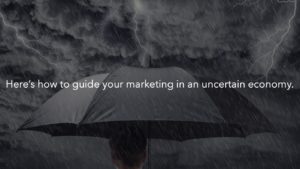In 2020 it’s game on for utility marketers. With pressure from utility leaders to generate incremental revenue, customers demanding whole new types of engagement; and the expectations of regulators and shareholders to be good corporate citizens, utility marketers are under more pressure than ever to “get the marketing right”. Here are the top 5 energy marketing trends for 2020 to take advantage of to help you get your marketing right.
1. New Business Models & New Marketing Departments
We are barely into 2020 and we are already seeing C-suite executives continuing to put pressure on their marketing leads to market new business models in an effort to generate incremental revenue. Couple this with changing customer demands for more innovative energy-related products and services and the game is on. But… There is a weak link and utilities will make big changes in 2020 to get rid of it. The weak link? The current in-house marketing team structure of most utilities and the common, but faltering, model of having the big “implementation” companies try to be the outsourced marketing team. Here are the three things inside this trend that utilities will do this year to divest of the weak links:
- Restructure internal teams to take over/centralize utility-wide marketing needs for consistency and efficiency
- Hire more experienced marketing specialists into these new team structures
- Divest of pseudo marketing vendors while also hiring dedicated marketing agencies to augment internal teams during the restructuring
Georgia Power got a jump start on this trend last year and is one of the trendsetters going into 2020. They have restructured their marketing department, they are hiring more experienced marketers and are divesting of vendors that don’t bring aggressive new marketing and fresh ideas to the table.
ID Lab sees, firsthand, the market movements behind this trend. In just the last eight months we have had two clients ask us to help find and/or market new lines of business with the objective of generating incremental revenue of $100 million+ within the next 36 months – and these are just the big asks.
As an example of a new business model forcing changes in marketing, Sacramento Municipal Utility District (SMUD) offers a program design and implementation for Community Choice Aggregation (CCA) programs (CCAs enable communities to choose their electricity and natural gas sources and aggregate their purchasing power). By late last year, eight states had approved CCA programs and several more were considering them. SMUD’s services include data, design research, energy acquisition and transportation, CSR (customer service reps), billing, and contracting assistance. All of which have to be marketed in all-new ways.
On the customer products side of this 2020 trend, utilities are doubling down on taking a big share of the Smart Home market and selling complete home solutions directly to customers. This will force new/better ecommerce practices, consumer goods marketing and all-new ways of “selling” and supporting hard goods (products) from utilities in 2020.
One of the other impacts we will see from this trend of new business models and new marketing team structures is tough competition for experienced marketers beginning in late Q1 as utilities put out more job requisitions. We also expect that several current implementor and marking vendor contracts will come up for review/modification beginning in late Q2.
2. Paid Search
While paid search (predominantly Google Ads) is a mainstay in private sector marketing, it’s not the case with most utilities. Because utilities have traditionally not had to aggressively compete for customers, paid search has not been a core tactic. However, 2020 will build on the moderate growth of paid search we saw in 2019 to become a more frequently used arrow in the marketing quiver of utilities. This is driven by the need to increase awareness of new lines of business and to generate better conversion in order to steal away market share from competitors.
As utilities increase their use of paid search, we offer some advice. Consider manually managing your paid search campaigns (or have your agency manually manage them). In 2020 we, ID Lab, will continue to manually manage most of our clients’ campaigns instead of using Google’s automated tools. While the automated tools lessen the labor needed to manage campaigns, they don’t always generate the stronger results we get when we manage them manually. We’ve been getting 2x to 3x better results with our manual management versus Google’s automated tools. For reference, Google says that businesses make an average of $2 for every $1 they spend on Google Ads. WordStream asserts that the average CPC (cost per click) is $2.69 with an average CTR (click-thru rate) of 3.17. Imagine getting 2x to 3x these results by putting in the effort to manually manage your campaigns as you ride this energy marketing trend in 2020.
3. Content Strategy
So we’re on the same page: content strategy is the planning, creation, delivery, and governance of content. Content not only includes the words on the page but also imagery and multimedia.
Imagine writing your resume, putting it on a web site four pages deep with only one link to it and telling hiring managers to go find it for themselves. That’s the equivalent content experience customers have with much of the content utilities generate. But it’s not always the utility’s fault. Utilities generate vast amounts of content every year. Between regulatory requirements, program promotions, shareholder relations, community activities, ESG (environmental, social and governance) efforts – and the list goes on—the amount of content adds up quickly. The foundational problem is that utilities aren’t staffed with content strategists.
The common result of generating all of this content is, at best, customer frustration and at worst, important messages are buried which makes utilities appear out of touch or like their hiding something. To add insult to injury utilities also don’t have the time and/or resources to create an SEO (search engine optimization) strategy which means they don’t get the positive search results they deserve.
As we move into 2020 we’re seeing yet another shift in utility-generated content that gives further momentum to content strategy trend—video. Why? Because utilities get it. They see that video consumption on mobile devices rises a whopping 100 percent each year. They also see that 78 percent of people report watching videos online each week and 54% demand more video content on top of what they already consume.
Over the course of 2019, we saw a 100% year-over-year increase in utilities requesting content strategies, content management plans and/or the deployment of cross-department SEO tactics. As we move into 2020, requests for content strategy-related and SEO help are already up 100% over 2019 which, combined with an increase in unique content generation requests, tells us that this is an energy marketing trend to pay attention to.
4. Micro-influencers
Influencer marketing isn’t new. But, because it’s been so successful for a few years now the big-time influencers are now in the driver’s seat. Gone are the days of sending them freebies or exclusives in hopes they’ll say nice things about you—now its payment tables and price lists. It’s gotten expensive and candidly, it’s not often that utilities can get much value from the big influencers because the big influencers are often national or international players whereas utilities have much tighter geographic needs (their service areas). Because of these realities utilities haven’t often used influencer marketing. However, in 2019 several utilities, like those in California, were put in the tough position of having to get messages out that were more credible coming from anyone but the utility. This created initial momentum around the use of influencers by utilities.
Because of 2019’s momentum, we’re going to see even more use of influencers in 2020 but it’s going to be micro-influencers. Micro-influencers are small to medium-sized influencers with narrower niches. They are popular enough to be influential, in close touch with their followers and much less expensive. Ad week recently released a study revealing the real effectiveness of micro-influencers. Categorized as accounts with around 30,000 followers, micro-influencers had 60% higher engagement while being 6.7x more cost-effective than influencers with more followers.
As an aside, Kim Kardashian West said she gets about $300,000 to $500,000 for a single Instagram post. For longer-term endorsements, Kardashian West’s attorney says she agreed to a $6 million annual deal with a wearables company last year.
Back to micro-influencers, they also often have better engagement rates than larger influencers. This stands to reason as they have fewer followers so they can dedicate more personalized time to each follower. Plus, it’s easier to specialize in a niche with micro-influencers, as they often represent niches themselves and they can also be more geo-focused which better serves the needs of utilities.
4. Polished & Engaging Emails
Email, the lifeblood of almost every utility in the country, remains nearly as powerful as ever. Outside of the energy sector, the ROI of email marketing can be as high as 4400%. However, the strength of email marketing is showing signs of weakening in both the private sector and for utilities. In an unofficial survey of one of the marketing groups we belong to (over 100 marketing professionals), the group is seeing a slowing in CTR (click-thru rate)—down almost 10% over the past two years. However, rather than abandoning the channel, email marketers are reviving it by stepping up their design game.
Via DTE
As a sign of this, 2019 saw a decline in plain-text emails and newsletters. In their place are beautiful, pixel-perfect emails that look right out of a designer’s portfolio. This high-design will be the growing trend in 2020. Email marketing will look and function akin to web pages—with high interactivity and “clickability”.
These polished emails do more than visually impress, they increase conversion rates. Readers click well-designed buttons with related images more readily than plain-text links.
But using a web page-like email design isn’t enough; you have to go further with great visuals and UX-centric design. But keep in mind, there are realities to consider when creating beautiful emails. Constant Contact reminds us that the right balance for emails is 20 lines of text and 3 images. Considering the potential ROI we mentioned earlier, it’s worth the effort to make sure your emails are as engaging and beautiful as possible if you’re going to stand out in 2020. Remember, customer expectations regarding the quality of emails are raised by the overall market so utility emails have to compete for customer attention like anyone else.
Conclusion
At this point, I hope you are thinking to yourself “that was great, but I want to hear about more trends!” I applaud your enthusiasm and there are more trends we see for 2020 but these are the ones to focus on. We picked these trends because they will have the greatest positive impact on your marketing this year.
Focus on taking advantage of these utility marketing trends; get them right and you will be on your marketing game for 2020. Enjoy the ride!




